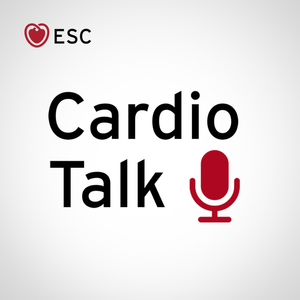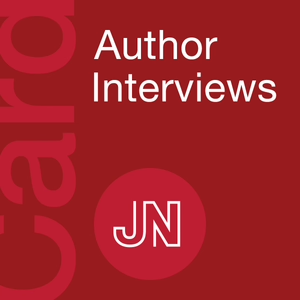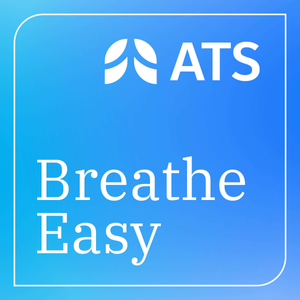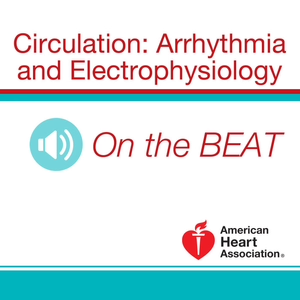
Circulation: Arrhythmia and Electrophysiology October 2019 Issue
10/21/19 • 16 min
Dr Paul Wang: Welcome to the monthly podcast, On the Beat for Circulation: Arrhythmia and Electrophysiology. I'm Dr Paul Wang, editor in chief, with some of the key highlights from this month's issue.
In our first paper, in a single‐center observational cohort study, Owen Donnellan and Associates compared arrhythmia recurrence rates in morbidly obese patients who underwent prior bariatric surgery, with those of non-obese patients following atrial fibrillation ablation. In addition to morbidly obese patients who did not undergo bariatric surgery, they matched 51 morbidly obese patients' body mass index, 40 kilograms per meter squared, who had undergone prior bariatric surgery in a two to one manner with 102 non-obese patients, and 102 morbidly obese patients without bariatric surgery on the basis of age, gender, and timing of atrial fibrillation ablation. From the time of bariatric surgery to ablation, bariatric surgery was associated with a significant reduction in BMI. 47.6 to 36.7 and reduction in systolic blood pressure, 145 to 118, P < 0.001.
During a mean follow up of 29 months following ablation, recurrent arrhythmia occurred in 10 out of 51 or 20 patients in a bariatric surgery group, compared to 25 out of 102 patients, 24.5% in a non-obese group, and 56 out of 102 or 55% in the non-bariatric surgery morbidly obese group. No procedural complications were observed in the bariatric surgery group. In our next paper, Martin Andreas and Associates examined whether noninvasive, low-level, transcutaneous electrical stimulation of the greater auricular nerve reduced the risk of postoperative atrial fibrillation, in a pilot of patients undergoing cardiac surgery. After cardiac surgery, electrodes were applied in the triangular fossa of the ear. Stimulation, amplitude 1-million-amp frequency, one Hertz for 40 minutes, followed by a 20-minute break, was performed for up to two weeks after cardiac surgery. Patients were randomized into sham, N equals 20 or treatment group, N equals 20, for low- level, transcutaneous electrical stimulation. Patients receiving low-level, transcutaneous stimulation had a significant reduced incidence of postoperative atrial fibrillation. Four out of 20, compared to controls 11 out of 20. P equals 0.02.
The median duration of postoperative atrial fibrillation was comparable between the treatment group and control group. No effect on low-level stimulation on CRP or IL-6 levels was detectable. In our next paper, Kazuki Iso and Associates examine whether the vagal response phenomenon is common to patients without atrial fibrillation. Continuous, high- frequent stimulation of the left atrial ganglion and plexus was performed in 42 patients, undergoing ablation for atrial fibrillation. In 21 patients undergoing ablation for left-sided accessory pathway, the high frequency stimulation, 20 Hertz at 25 milliamps of 10 millisecond pulse duration, was applied for five seconds at three sites within the presumed anatomical area of each of the five major left atrial ganglion plexus, for a total of 15 sites per patient. The authors define vagal response to high frequency stimulation, as prolongation of the R interval by > 50% in comparison to the mean pre-high-frequency stimulation RR interval, average over 10 beats.
In active ganglion plexus areas, is areas in which vagal response was elicited. Overall, more active ganglion plexi or GP areas were found in the atrial fibrillation group patients, than in the non-atrial fibrillation group patients. And in all five major GPS, the maximum R interval during high-frequency stimulation was significantly prolonged in atrial fibrillation patients. After multivariate adjustment, association was established between the total number of vagal response sites and the presence of atrial fibrillation. The authors concluded that the significant increase in vagal responses elicited in patients with atrial fibrillation, compared to responses in non-atrial fibrillation patients, suggests that the vagal responses is to hypercan stimulations, reflect an abnormally increased ganglion plexi activity, specific to atrial fibrillation substrates.
In our next paper, Vidal Essebag and Associates combine the data from the Bruise Control One and Two studies to evaluate the effect of concomitant antiplatelet therapy on clinically significant hematomas, and to understand the relative risk of clinically significant hematomas in patients treated with DOAC versus continued Warfarin. The Bruise Control study demonstrated that perioperative Warfarin continuation, reduced clinically- significant hematomas by 80%, compared to Heparin bridging. 3.5% versus 16%. Bruise Control Two observed a similarly low risk of clinically-significant hematomas when comparing continued versus interrupted direct oral anticoagulant. 2.1% in both groups. A total of 1,343 patients were included in Bruise Control One and Bruise Control Two, the primary outcom...
Dr Paul Wang: Welcome to the monthly podcast, On the Beat for Circulation: Arrhythmia and Electrophysiology. I'm Dr Paul Wang, editor in chief, with some of the key highlights from this month's issue.
In our first paper, in a single‐center observational cohort study, Owen Donnellan and Associates compared arrhythmia recurrence rates in morbidly obese patients who underwent prior bariatric surgery, with those of non-obese patients following atrial fibrillation ablation. In addition to morbidly obese patients who did not undergo bariatric surgery, they matched 51 morbidly obese patients' body mass index, 40 kilograms per meter squared, who had undergone prior bariatric surgery in a two to one manner with 102 non-obese patients, and 102 morbidly obese patients without bariatric surgery on the basis of age, gender, and timing of atrial fibrillation ablation. From the time of bariatric surgery to ablation, bariatric surgery was associated with a significant reduction in BMI. 47.6 to 36.7 and reduction in systolic blood pressure, 145 to 118, P < 0.001.
During a mean follow up of 29 months following ablation, recurrent arrhythmia occurred in 10 out of 51 or 20 patients in a bariatric surgery group, compared to 25 out of 102 patients, 24.5% in a non-obese group, and 56 out of 102 or 55% in the non-bariatric surgery morbidly obese group. No procedural complications were observed in the bariatric surgery group. In our next paper, Martin Andreas and Associates examined whether noninvasive, low-level, transcutaneous electrical stimulation of the greater auricular nerve reduced the risk of postoperative atrial fibrillation, in a pilot of patients undergoing cardiac surgery. After cardiac surgery, electrodes were applied in the triangular fossa of the ear. Stimulation, amplitude 1-million-amp frequency, one Hertz for 40 minutes, followed by a 20-minute break, was performed for up to two weeks after cardiac surgery. Patients were randomized into sham, N equals 20 or treatment group, N equals 20, for low- level, transcutaneous electrical stimulation. Patients receiving low-level, transcutaneous stimulation had a significant reduced incidence of postoperative atrial fibrillation. Four out of 20, compared to controls 11 out of 20. P equals 0.02.
The median duration of postoperative atrial fibrillation was comparable between the treatment group and control group. No effect on low-level stimulation on CRP or IL-6 levels was detectable. In our next paper, Kazuki Iso and Associates examine whether the vagal response phenomenon is common to patients without atrial fibrillation. Continuous, high- frequent stimulation of the left atrial ganglion and plexus was performed in 42 patients, undergoing ablation for atrial fibrillation. In 21 patients undergoing ablation for left-sided accessory pathway, the high frequency stimulation, 20 Hertz at 25 milliamps of 10 millisecond pulse duration, was applied for five seconds at three sites within the presumed anatomical area of each of the five major left atrial ganglion plexus, for a total of 15 sites per patient. The authors define vagal response to high frequency stimulation, as prolongation of the R interval by > 50% in comparison to the mean pre-high-frequency stimulation RR interval, average over 10 beats.
In active ganglion plexus areas, is areas in which vagal response was elicited. Overall, more active ganglion plexi or GP areas were found in the atrial fibrillation group patients, than in the non-atrial fibrillation group patients. And in all five major GPS, the maximum R interval during high-frequency stimulation was significantly prolonged in atrial fibrillation patients. After multivariate adjustment, association was established between the total number of vagal response sites and the presence of atrial fibrillation. The authors concluded that the significant increase in vagal responses elicited in patients with atrial fibrillation, compared to responses in non-atrial fibrillation patients, suggests that the vagal responses is to hypercan stimulations, reflect an abnormally increased ganglion plexi activity, specific to atrial fibrillation substrates.
In our next paper, Vidal Essebag and Associates combine the data from the Bruise Control One and Two studies to evaluate the effect of concomitant antiplatelet therapy on clinically significant hematomas, and to understand the relative risk of clinically significant hematomas in patients treated with DOAC versus continued Warfarin. The Bruise Control study demonstrated that perioperative Warfarin continuation, reduced clinically- significant hematomas by 80%, compared to Heparin bridging. 3.5% versus 16%. Bruise Control Two observed a similarly low risk of clinically-significant hematomas when comparing continued versus interrupted direct oral anticoagulant. 2.1% in both groups. A total of 1,343 patients were included in Bruise Control One and Bruise Control Two, the primary outcom...
Previous Episode
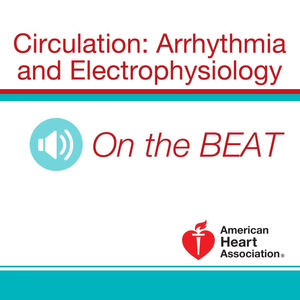
Circulation: Arrhythmia and Electrophysiology September 2019 Issue
Dr Wang: Welcome to the monthly podcast, On the Beat, for Circulation: Arrhythmia and Electrophysiology. I'm Dr Paul Wang, Editor-in-Chief, with some of the key highlights from this month's issue.
In our first paper, Ying Tian and associates examine the effects and long-term outcomes of percutaneous stellate ganglion blockade in the setting of drug refractory electrical storm due to ventricular arrhythmia. They studied 30 consecutive patients over nearly a five-year period. They used bupivacaine alone, or in combination with lidocaine injected into the neck with good local anesthetic spread in the vicinity of the left stellate ganglion in 15 patients, or both stellate ganglion in 15 patients.
The mean left ventricular ejection fraction was 34%. At 24 hours, 60% of patients were free of ventricular arrhythmia. Patients whose ventricular arrhythmia was controlled had a lower hospital mortality rate than patients whose ventricular arrhythmia continued. 5.6 versus 50%, P equals 0.009. Implantable cardioverter-defibrillator interrogation showed a significant 92% reduction in ventricular arrhythmia episodes from 26 to 2 in the 72 hours after stellate ganglion blockade, P less than 0.001.
Patients who died during the same hospitalization, N equals 7, were more likely to have ischemic cardiomyopathy, 100% versus 43.5%. And recurrent ventricular arrhythmias within 24 hours, 85.7% versus 26.1%. There were no procedure related complications.
In our next paper, Zachi Attia and associates hypothesized that a convolutional neural network could be trained through a process called 'deep learning' to predict a person's age and gender using only 12-lead electrocardiogram signals. They trained convolutional neural network using 10 second samples of 12-lead ECG signals from 499,727 patients to predict gender and age. The networks were tested on a separate cohort of 275,056 patients. For gender classification, the model obtained 90.4% classification accuracy with an area under the curve of 0.97. In the independent test data, age was estimated as a continuous variable with an average error of 6.9 years, R squared equals 0.7.
Among 100 hundred patients with multiple ECGs over the course of at least two decades of life, most patients, 51%, had an average error between real age and convolutional neural network predicted age of less than seven years. Major factors seen amongst patients with convolutional neural network predicted age that exceeded chronologic age by greater than seven years included low ejection fraction, hypertension, and coronary disease, P less than 0.1. In the 27% of patients whose correlation was greater than 0.8, between convolutional neural network predicted and chronological age, no incident events occurred over follow up 30 years.
The authors concluded that applying artificial intelligence to the ECG allows prediction of patient, gender, and estimation of age. The ability of artificial intelligent algorithm to determine physiological age with further validation may serve as a measure of overall health.
In our next paper, Zain Ul Abideen Asad and associates performed a meta-analysis of randomized control trials in order to compare the efficacy and safety of catheter ablation with medical therapy for atrial fibrillation with the primary outcome being all-cause mortality. They examined 18 randomized controlled trials comprising 4,464 patients. Catheter ablation resulted in significant reduction in all-cause mortality, relative risk of 0.69 that was driven by patients with atrial fibrillation and heart failure in reduced ejection fraction, relative risk 0.52.
Catheter ablation resulted in significantly fewer cardiovascular hospitalizations, hazard ratio of 0.56, and fewer recurrences of atrial arrhythmia, relative risk 0.42. Subgroup analysis suggested that younger patients, age less than 65 years, and men derived more benefit from catheter ablation compared to medical therapy.
In our next paper, Felipe Kazmirczak, Ko-Hsuan Amy Chen, and associates examined patients with cardiac sarcoidosis meeting guideline criteria for implantable defibrillator implantation in a large retrospective cohort study of patients with biopsy proven sarcoidosis and known or suspected cardiac sarcoidosis undergoing cardiovascular magnetic resonance imaging. The authors found that in 290 patients, the class one and class 2A recommendation identified all patients who experienced a composite endpoint of significant ventricular arrhythmia or sudden cardiac death over a mean follow-up of three years.
Patients meeting class one recommendations had a significantly higher incidence of composite endpoint than those meeting class 2A recommendations. Left ventricular ejection fraction greater than 35% with greater than 5.7% late gadolinium enhancement and cardiovascular negative residence imaging was as sensitive as or significantly more specific than left tri...
Next Episode
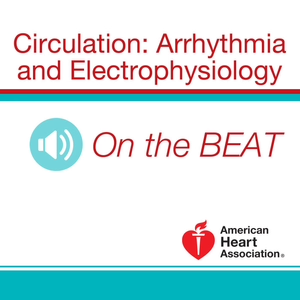
Circulation: Arrhythmia and Electrophysiology November 2019 Issue
Dr Paul Wang: Welcome to the monthly podcast, On the Beat, for Circulation: Arrhythmia and Electrophysiology. I'm Dr Paul Wang, editor in chief, with some of the key highlights from this month's issue.
In our first paper, Leroy Joseph and associates examined whether an increase in dietary saturated fat could lead to abnormalities of calcium homeostasis and heart rhythm, by an NADPH oxidase 2, NOX2-dependent mechanism.
In mice on high fat diets, they found that saturated fat activates NOX, whereas polyunsaturated fat does not. The high saturated fat diet increased repolarization heterogeneity in ventricular tachycardia, VT inducibility in perfused hearts. Pharmacologic inhibition or genetic deletion of NOX2 prevented arrhythmogenic abnormalities in vivo during high saturated fat diet and resulted in less inducible VT. On the other hand, high saturated fat diet activates calcium calmodulin dependent protein kinase in the heart, which contributes to abnormal calcium handling, promoting arrhythmia. This work suggests that a molecular mechanism links cardiac metabolism to arrhythmia and it suggest that NOX2 inhibitors could be a novel therapy for heart rhythm abnormalities caused by cardiac lipid overload.
In our next paper, Misha Regouski and associates examined whether the relationship between endurance exercise and atrial fibrillation, or AF, is dependent on atrial myopathy. They examined six cardiac specific TGFβ1 transgenic and six wild type goats. Pacemakers were implanted in all animals for continuous arrhythmia monitoring and AF inducibility. AF inducibility was evaluated using five separate ten second bursts of atrial pacing. At baseline sustained AF greater than 30 seconds was induced with 10 seconds of atrial pacing in 4 out of 6 transgenic goats, compared to zero out of six wild type controls, P less than 0.05. No spontaneous AF was observed at baseline, three months of progressive endurance exercise up to 90 minutes at 4.5 miles per hour was performed. The authors observed that between two to three months of exercise, three out of six transgenic animals developed self-terminating spontaneous atrial fibrillation compared to zero out of six wild type animals, (P less than 0.05). There was an increase in AF inducibility in both transgenic and wild type animals during the first two months of exercise with partial normalization at three months.
These changes in AF susceptibility were associated with a decrease in circulating micro RNA 21 and micro RNA 29 during the first two months of exercise, with partial normalization three months in both transgenic and wild type animals. The authors concluded that endurance exercise appears to increase inducible AF secondary to altered expression of key profibrotic biomarkers that is independent of the presence of an atrial myopathy.
In our next paper, Seokhun Yang and associates examined whether there is an association between lifetime exposure to endogenous sex hormone, and incident atrial fibrillation, or AF, in subsequent ischemic stroke. They studied nearly five million natural postmenopausal women aged 40 years or greater without prior history of AF and with breast cancer. The primary end point was incident AF and the secondary end point was subsequent ischemic stroke once AF is developed. During the mean follow up of 6.3 years, shorter total reproductive years (<30 years) was associated with 7% increased risk of AF after adjusting for confounding variables. Adjusted hazard ratio, 1.07. Risk of AF declined progressively with every five-year increment in total reproductive years. P for trend less than 0.001. However, the prolonged, two years or greater use of hormone replacement therapy after menopause was paradoxically associated with a 3% increase in AF risk. (Adjusted ratio 1.03).
For the secondary endpoint analysis, the risk of ischemic stroke after AF development significantly decreased with each five-year increment in total reproductive years with less than 30 years as a reference. (Adjusted hazard ratio 0.93, for 30 to 34 years 0.84, for 35 to 39 years is 0.88, for 40 years or greater. P for trend less than 0.001) the authors concluded that women with natural menopause shortened lifetime exposure to endogenous sex hormone, that is, shorter total reproductive years, was significantly associated with a higher risk of AF and subsequent ischemic stroke. In contrast, prolonged exogenous hormone replacement therapy increased the risk of incident AF.
In our next paper, Stephan Hohmann and associates examine the accuracy of electrocardiographic imaging, ECGi, in a closed chest porcine model. A total of 109 endocardial and nine epicardial locations were paced in nine pigs. ECGi predicted the correct chamber of origin in 85% of atrial and 92% of ventricular sites. Lateral locations were predicted in the correct chamber more often than septal location. (97% versus 79% P=0.01) Absolute distances in space bet...
If you like this episode you’ll love
Episode Comments
Generate a badge
Get a badge for your website that links back to this episode
<a href="https://goodpods.com/podcasts/circulation-arrhythmia-and-electrophysiology-on-the-beat-94401/circulation-arrhythmia-and-electrophysiology-october-2019-issue-5066048"> <img src="https://storage.googleapis.com/goodpods-images-bucket/badges/generic-badge-1.svg" alt="listen to circulation: arrhythmia and electrophysiology october 2019 issue on goodpods" style="width: 225px" /> </a>
Copy
